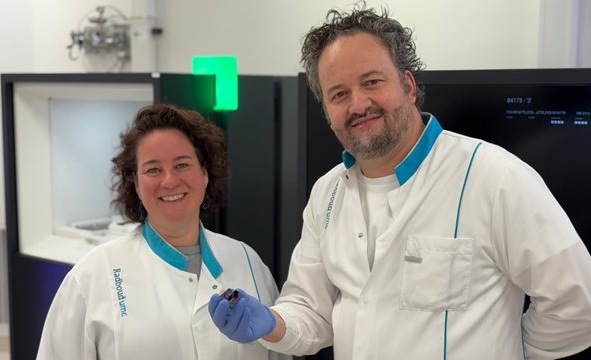Innovative Nano-Biosensor Developed for Rapid Detection of Viruses
|
By LabMedica International staff writers Posted on 23 Mar 2016 |
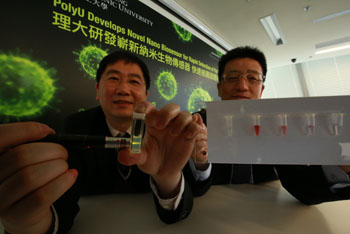
Image: A novel nano-biosensor has been developed for lower-cost, rapid virus detection based on upconversion luminescence resonance energy transfer (LRET) technology and DNA oligo hybridization. Testing takes only 2–3 hours, about 10x faster traditional clinical methods (Photo courtesy of the Hong Kong Polytechnic University).
Scientists have invented a compact, easy-to-use biosensor for rapid, sensitive detection of flu and other viruses by utilizing the optical method of upconversion luminescence resonance energy transfer (LRET).
The new method, invented by researchers at the Hong Kong Polytechnic University (PolyU; Hong Kong), involves simple operational procedures that significantly reduce testing time from around 1–3 days to 2–3 hours, making it over 10 times quicker than traditional clinical methods. Furthermore, it is a low-cost test—about 80% lower than traditional tests, and the technology can be widely used to detect different types of viruses
RT-PCR is expensive and time-consuming while the sensitivity for ELISA is relatively low. Such limitations make these methods difficult for use in front-line and on-site virus detection. This challenge paved the way for the researchers to develop a new biosensor based on the luminescent technique.
The luminescent technique operates analogous to two matching pieces of magnet with attraction force. It involves the development of upconversion nanoparticles (UCNPs) conjugated with an oligo probe whose DNA base pairs are complementary with that of the gold nanoparticles (AuNPs) flu virus oligo. Given the complementarity, the two oligos undergo DNA-DNA hybridization. Upon being illuminated by a portable near-infrared laser pen, the UCNPs emit eye-visible green light while the AuNPs would absorb the green light. One can easily quantify the concentration of the targeted flu virus by measuring the decrease in green light intensity.
Initially, the researchers used upconversion LRET for ultrasensitive virus detection in liquid-phase system. The team then further improved the sensitivity by using a solid-phased nanoporous membrane system (NAAO). As NAAO membrane consists of many hollow channels, it allows more space for oligo hybridization to take place, increasing sensitivity by over 10 folds compared to the liquid-phase system, based on detection using inactivated virus samples.
The new biosensor does not require expensive instruments and sophisticated operational skills, and has sensitivity comparable to traditional clinical methods. In comparison to conventional downconversion luminescent technique, it causes low damage to genetic materials and does not induce background fluorescence. In addition, a complementary probe can be designed to target detection of any virus with known genetic sequence. In other words, the new method can be widely used for the detection of different types of viruses simply by modifying the UCNPs capture probe.
The team will continue to enhance the biosensor for virus detection, including increasing sensitivity and specificity, and developing a matrix for multiplex detection of multiple flu viruses on a single testing platform.
The related results have been recently published in the two nanomaterial research journals ACS Nano and Small.
Related Links:
The Hong Kong Polytechnic University
The new method, invented by researchers at the Hong Kong Polytechnic University (PolyU; Hong Kong), involves simple operational procedures that significantly reduce testing time from around 1–3 days to 2–3 hours, making it over 10 times quicker than traditional clinical methods. Furthermore, it is a low-cost test—about 80% lower than traditional tests, and the technology can be widely used to detect different types of viruses
RT-PCR is expensive and time-consuming while the sensitivity for ELISA is relatively low. Such limitations make these methods difficult for use in front-line and on-site virus detection. This challenge paved the way for the researchers to develop a new biosensor based on the luminescent technique.
The luminescent technique operates analogous to two matching pieces of magnet with attraction force. It involves the development of upconversion nanoparticles (UCNPs) conjugated with an oligo probe whose DNA base pairs are complementary with that of the gold nanoparticles (AuNPs) flu virus oligo. Given the complementarity, the two oligos undergo DNA-DNA hybridization. Upon being illuminated by a portable near-infrared laser pen, the UCNPs emit eye-visible green light while the AuNPs would absorb the green light. One can easily quantify the concentration of the targeted flu virus by measuring the decrease in green light intensity.
Initially, the researchers used upconversion LRET for ultrasensitive virus detection in liquid-phase system. The team then further improved the sensitivity by using a solid-phased nanoporous membrane system (NAAO). As NAAO membrane consists of many hollow channels, it allows more space for oligo hybridization to take place, increasing sensitivity by over 10 folds compared to the liquid-phase system, based on detection using inactivated virus samples.
The new biosensor does not require expensive instruments and sophisticated operational skills, and has sensitivity comparable to traditional clinical methods. In comparison to conventional downconversion luminescent technique, it causes low damage to genetic materials and does not induce background fluorescence. In addition, a complementary probe can be designed to target detection of any virus with known genetic sequence. In other words, the new method can be widely used for the detection of different types of viruses simply by modifying the UCNPs capture probe.
The team will continue to enhance the biosensor for virus detection, including increasing sensitivity and specificity, and developing a matrix for multiplex detection of multiple flu viruses on a single testing platform.
The related results have been recently published in the two nanomaterial research journals ACS Nano and Small.
Related Links:
The Hong Kong Polytechnic University
Latest Technology News
- AI Saliva Sensor Enables Early Detection of Head and Neck Cancer
- AI-Powered Biosensor Technology to Enable Breath Test for Lung Cancer Detection
- AI Model Achieves Breakthrough Accuracy in Ovarian Cancer Detection
- Portable Biosensor Diagnoses Psychiatric Disorders Using Saliva Samples
- Cell-Sorting Device Uses Electromagnetic Levitation to Precisely Direct Cell Movement

- Embedded GPU Platform Enables Rapid Blood Profiling for POC Diagnostics
- Viral Biosensor Test Simultaneously Detects Hepatitis and HIV
- Acoustofluidic Device to Transform Point-Of-Care sEV-Based Diagnostics
- AI Algorithm Assesses Progressive Decline in Kidney Function
- Taste-Based Influenza Test Could Replace Nasal Swabs with Chewing Gum
- 3D Micro-Printed Sensors to Advance On-Chip Biosensing for Early Disease Detection
Channels
Clinical Chemistry
view channel
Chemical Imaging Probe Could Track and Treat Prostate Cancer
Prostate cancer remains a leading cause of illness and death among men, with many patients eventually developing resistance to standard hormone-blocking therapies. These drugs often lose effectiveness... Read more
Mismatch Between Two Common Kidney Function Tests Indicates Serious Health Problems
Creatinine has long been the standard for measuring kidney filtration, while cystatin C — a protein produced by all human cells — has been recommended as a complementary marker because it is influenced... Read moreMolecular Diagnostics
view channel
Blood Test Accurately Detects Brain Amyloid Pathology in Symptomatic Patients
New research has reinforced the use of a novel blood test as a highly accurate tool for detecting brain amyloid pathology in symptomatic patients, helping healthcare professionals in diagnosing Alzheimer’s disease.... Read more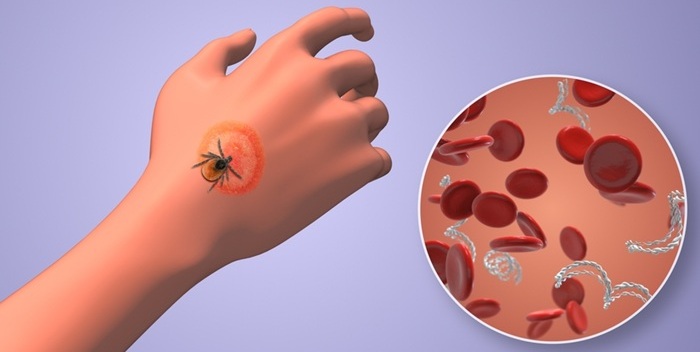
New Molecular Test Improves Diagnostic Accuracy of Lyme Disease
Diagnosing Lyme disease early remains one of the biggest challenges in infectious disease care. The condition is increasing across the United States, especially in the Northeast, although many patients... Read moreHematology
view channel
Platelet Activity Blood Test in Middle Age Could Identify Early Alzheimer’s Risk
Early detection of Alzheimer’s disease remains one of the biggest unmet needs in neurology, particularly because the biological changes underlying the disorder begin decades before memory symptoms appear.... Read more
Microvesicles Measurement Could Detect Vascular Injury in Sickle Cell Disease Patients
Assessing disease severity in sickle cell disease (SCD) remains challenging, especially when trying to predict hemolysis, vascular injury, and risk of complications such as vaso-occlusive crises.... Read more
ADLM’s New Coagulation Testing Guidance to Improve Care for Patients on Blood Thinners
Direct oral anticoagulants (DOACs) are one of the most common types of blood thinners. Patients take them to prevent a host of complications that could arise from blood clotting, including stroke, deep... Read moreImmunology
view channel
Chip Captures Cancer Cells from Blood to Help Select Right Breast Cancer Treatment
Ductal carcinoma in situ (DCIS) accounts for about a quarter of all breast cancer cases and generally carries a good prognosis. This non-invasive form of the disease may or may not become life-threatening.... Read more
Blood-Based Liquid Biopsy Model Analyzes Immunotherapy Effectiveness
Immunotherapy has revolutionized cancer care by harnessing the immune system to fight tumors, yet predicting who will benefit remains a major challenge. Many patients undergo costly and taxing treatment... Read morePathology
view channel
AI Tool Predicts Treatment Success in Rectal Cancer Patients
Artificial intelligence (AI) may soon help clinicians identify which rectal cancer patients are likely to respond well to treatment, using only the routine biopsy slides already obtained at diagnosis.... Read more
Blood Test and Sputum Analysis Predict Acute COPD Exacerbation
Chronic obstructive pulmonary disease (COPD) remains a major contributor to global illness, largely driven by cigarette smoking and marked by irreversible lung damage. Acute exacerbations can accelerate... Read more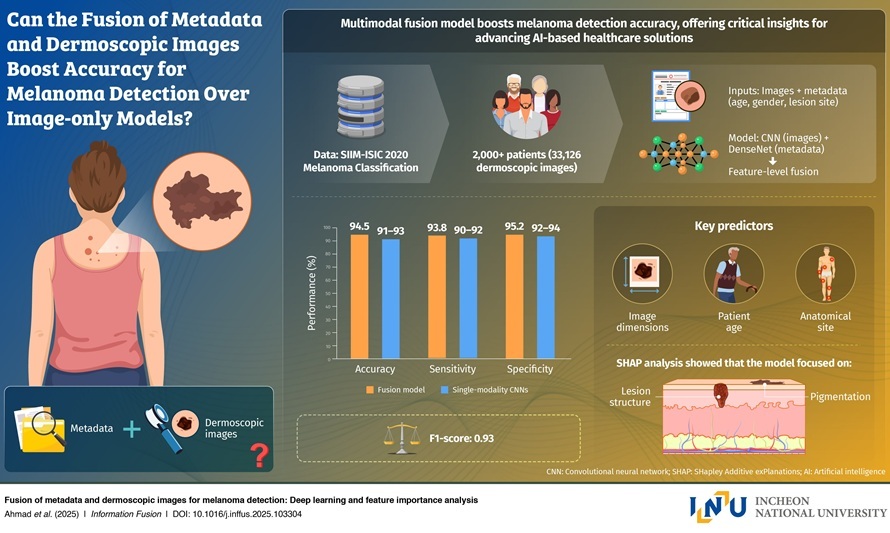
AI Tool to Transform Skin Cancer Detection with Near-Perfect Accuracy
Melanoma continues to be one of the most difficult skin cancers to diagnose because it often resembles harmless moles or benign lesions. Traditional AI tools depend heavily on dermoscopic images alone,... Read more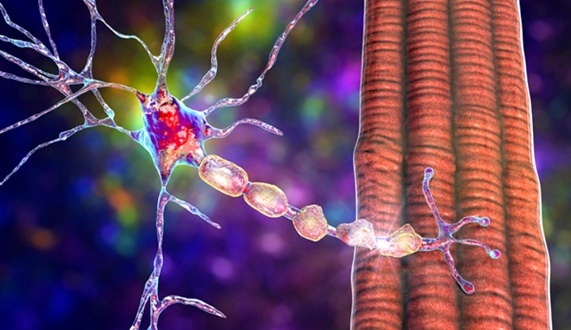
Unique Immune Signatures Distinguish Rare Autoimmune Condition from Multiple Sclerosis
Myelin oligodendrocyte glycoprotein antibody–associated disease (MOGAD) is a rare autoimmune disorder in which the immune system attacks the myelin sheath in the central nervous system. Although symptoms... Read moreTechnology
view channel
AI Saliva Sensor Enables Early Detection of Head and Neck Cancer
Early detection of head and neck cancer remains difficult because the disease produces few or no symptoms in its earliest stages, and lesions often lie deep within the head or neck, where biopsy or endoscopy... Read more
AI-Powered Biosensor Technology to Enable Breath Test for Lung Cancer Detection
Detecting lung cancer early remains one of the biggest challenges in oncology, largely because current tools are invasive, expensive, or unable to identify the disease in its earliest phases.... Read moreIndustry
view channel
Abbott Acquires Cancer-Screening Company Exact Sciences
Abbott (Abbott Park, IL, USA) has entered into a definitive agreement to acquire Exact Sciences (Madison, WI, USA), enabling it to enter and lead in fast-growing cancer diagnostics segments.... Read more




 assay.jpg)









